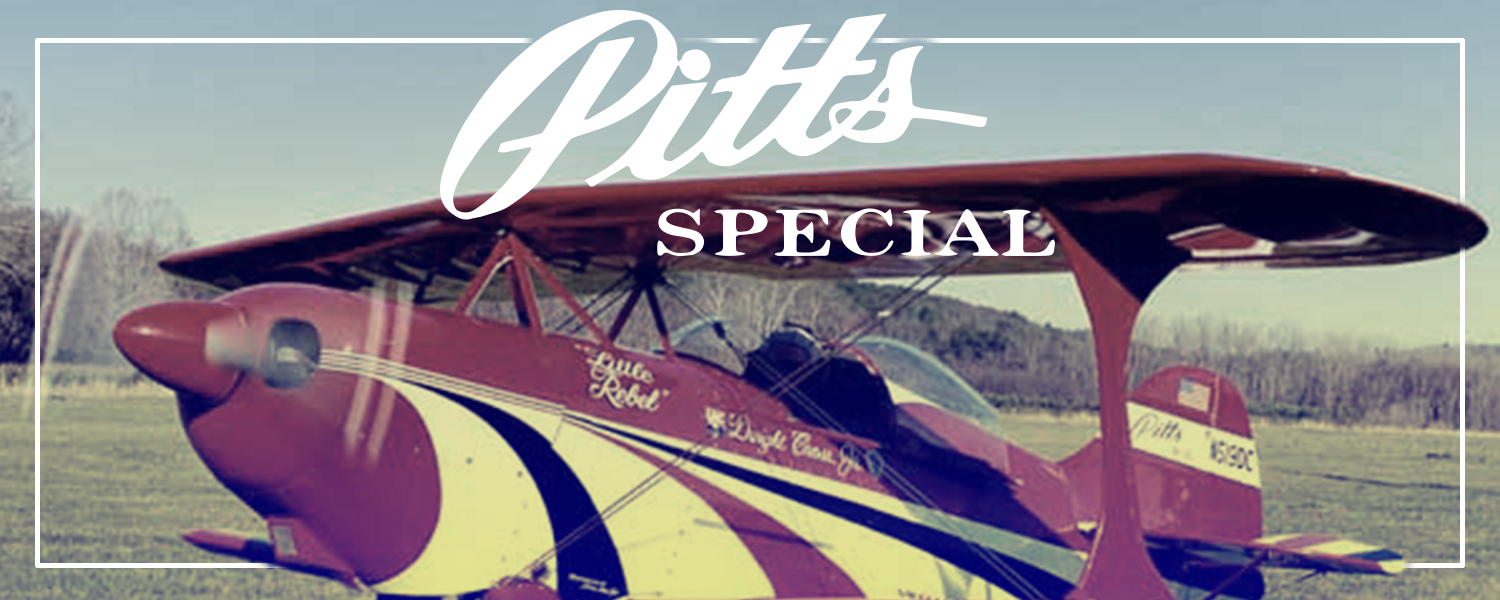
Pitts S1
Historical Information
The Pitts Special S1 Series
The Pitts Special S1 is certainly one of the most famous airplanes in history, and has probably performed at more airshows than any other type aerobatic aircraft. This distinctive, diminutive little biplane was created in 1945 by Curtis Pitts, a self-taught engineer with military aircraft inspection experience gained during World War Two. Helped by his friend Phil Quigley, they took a bit under a year building the biplane. Five minutes after the inspectors from the CAA (the predecessor to the FAA) left for the third time without giving him either an airworthiness certificate or an explanation, Curtis got tired of the bureaucrats and flew the 55-hp Pitts Special for the first time. Afterwards, Phil Quigley told Curtis that the CAA officials watched the first flight from behind some trees, but whether they saw it or not they must have decided it would be OK as they reappeared a week later with the certificate already written out.
Thus was born one of the most famous aircraft types in all of aviation history… the Pitts Special S1. More than any other type of plane, the Pitts Special is synonymous with aerobatics.
Needless to say, things have changed a bit since then. By today’s standards, it seems incredible that the first Pitts Special flew on only 55 horsepower — or even the 90-hp Franklin engine it was soon upgraded to — but fly it did, and superbly. Without the myriad of instrumentation and electronics usually installed today, the original Special only weighed around 500 lbs. empty. It flew “on the wing” – the extreme-horsepower, point-it-straight-up-and-accelerate flying style seen today wasn’t really around back then.
Almost paradoxically, the Pitts Special design itself was a major factor in the development of modern aerobatics. The design proved to be versatile enough to keep up as pilots explored new fire-breathing, eyeball-popping wild aerobatic maneuvers. Refinements were made, and the Pitts is still a competitive, serious aerobatic machine that regularly wins major contests and is perennially popular with aerobatic performers.
Just to put the design’s development into perspective, the “standard” engine for an S1-C or S1-SS now is a 180-hp Lycoming IO-360 – that is more than triple the power that the original Special flew with!
To this day, the Pitts Special S1 remains the benchmark by which all aerobatic airplanes planes are judged.
Steen Aero Lab currently offers plans and components for theS1-C and S1-SS versions of the Pitts Special. (Generally, you can swap the different wings around between these aircraft without much problem, as the fuselages are all built from the superset S1 plans.)
A QUICK GUIDE TO THE PITTS SPECIAL SERIES
** denotes a Steen Aero Lab aircraft
S1
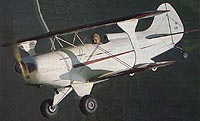 Photo courtesy Budd Davisson/Airbum.com |
The Pitts S1 was first built by Curtis Pitts and Phil Quigley in 1945. It had a 55 hp Lycoming (later, a 90 hp Franklin) and rigid landing gear. Only the lower wings had ailerons, and both wings used the M-6 airfoil. Ten more S1’s were planned in 1945, but only one was finished (with a stronger, enlarged fuselage.) Quigley flew it in airshows until Betty Skelton bought it in 1947. Registered as N22E and named “Little Stinker”, it helped her win the women’s national aerobatic title. In 1949, S1 number three was built for Caro Bayley with a 125 hp Lycoming. Curtis gave plans to two friends in the early 1950s, and one used 170 hp. Two more were built in 1955 – Pat Ledford’s N8L was the testbed to refine the plans for homebuilders.
S1-C Flatwing **
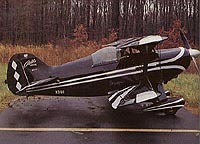 Photo courtesy Budd Davisson/Airbum.com |
The S1-C “Flatwing” Pitts became the first S1 for which plans were offered. It has a bungee landing gear and metal turtledeck, and retained the 2-aileron configuration. The C stood for the 100 hp Continental O-200 engine, but nearly all S1-Cs ended up with 180 hp Lycomings. The fuselage was later extended three inches. A quantity of S1Cs were factory-built in Afton, WY. Today, the S1-C is the “benchmark” version. Nearly all homebuilt S1’s used S1-C plans for the fuselage and tail, with supplemental wing plan options. Steen Aero Lab offers S1-C plans and a full line of components.
S1-D **
This is essentially a Flatwing S1-C with four ailerons and the longer fuselage. Steen Aero Lab offers supplemental plans to build a four aileron equivalent.
S1-E
This is a homebuilt S1-S, which was once offered in component form. Some S1-E kits became certified S1-S models, the exact number is unknown – there were around 100 S1-E kits sold. Like the S1-S, it has four ailerons.
S1-S Roundwing
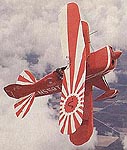 Photo courtesy Budd Davisson/Airbum.com |
The “Roundwing” Pitts was certified in 1973 and about 65 were built, though the exact number is fuzzy due to the crossover with the S1-E. The S1-S has symmetrical airfoils on both wings with identical angles of incidence, and four ailerons. A different airfoil is used on the top (forwardmost) wing to make it stall first whether upright or inverted. (Curtis patented this idea.) Only factory-built S1-S’s were available until production stopped in 1981 and Curtis released the plans. Unauthorized third-party “S1-S” wings (Sparcraft, etc.) began to appear in the 1970s, and “homebuilt” S1-S’s from before 1981 are either S1-E’s or don’t have Pitts-built wings.
S1-SS **
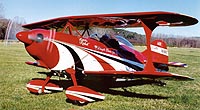 Steen Aero Lab photo. |
This modern version uses the “Super Stinker” (S-1-11) airfoils and aileron technology invented for world-class aerobatic competition. This 4-aileron design provides high roll rates while providing good centering, without the use of aileron spades. Steen Aero Lab first offered this option to builders in the 1990’s and it’s very popular today. “SS” wings can be retrofitted to nearly all S1’s without too much trouble, and unlike the S-1-11, it retains the classic round wingtips that most Pitts enthusiasts seem to prefer. Steen Aero Lab offers S1-SS plans and components.
S1-T
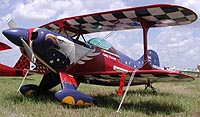 Steen Aero Lab photo. |
This certified airplane replaced the S1-S on the production line in 1981. It has 200 hp, a constant-speed prop, and four ailerons with a different design for a faster roll rate.
Ultimate
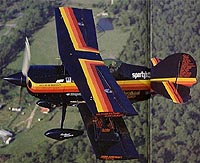 Photo courtesy Budd Davisson/Airbum.com |
This variation has distinctive squared-off wingtips and four full-length ailerons for very high roll rates. Some folks feel that they’re heavier, and few would argue that it’s better than the standard Pitts wing.
Super Stinker (S-1-11B)
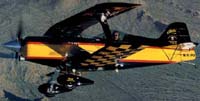 Photo courtesy Budd Davisson/Airbum.com |
The clean-sheet design known as the “Super Stinker” was intended for world-championship-level aerobatic competition and isn’t directly descended from the S1 series. However, the revolutionary aileron technology developed in this plane is extremely popular with homebuilders and is available in the Pitts S1-SS, available from Steen Aero Lab.
S2 Series
Predictably, the success of the S1 series lead to two-seat developments, thus the S2 was born. Versions include the S2-A, S2-B, and S2-C. The S2-S is a single-seat airshow bird similar to the S2-B.
Our thanks to…
A special thanks is due our good friend Budd Davisson (aka “Mr. Pitts Special”) for providing much historical info and many outstanding photos. Be sure to pay a visit to his great website – Airbum.com – you’ll be glad you did!